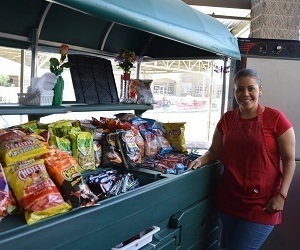Maricopa Unified School District students will be eating healthier foods when school starts next August.
The federal government is mandating all schools that participate in the federally-assisted National School Lunch Program offer snacks that meet their nutrition standards. MUSD participates in this program, which offers free or reduced price lunches to eligible students. The government reimburses the district for these lunches.
The new federal standards, which take effect July 1, apply to snacks – food and beverages served outside school meals.
"The Smart Snacks in School nutrition standards apply to all food and beverages available to students outside the school meals programs, including vending machines, a la carte, school stores, snack carts and fundraising," said Suzette Moe, director of the child nutrition program at the district.
The schools’ breakfast and lunch programs already comply with federal nutrition standards, Moe said.
Smart Snacks standards apply throughout the entire school day on campus beginning from midnight to 30 minutes after the final bell rings, she said.
Food served to students, as stated on the Smart Snacks in School website, will include the following ingredients:
- Fruit;
- Vegetable
- Dairy product
- Protein-rich food (meat, beans, poultry, seafood, eggs, nuts, seeds)
- Whole-grain rich food (first ingredient is a whole grain or product is 50 percent whole grains by weight)
- Combo food that has at least ¼ cup fruit and/or vegetable
Moe said the foods must also meet the federal government's standards for calories per item and a specific amount of fat, sugar or sodium.
"I think the new regulations for snacks (are) going to be a change for everyone, but a good change," Moe said. "Healthy active kids making good choices learn better in the classroom and grow into healthy adults."
The Healthy, Hunger-Free Kids Act of 2010 mandates "all foods regularly sold in schools during the school day, including vending machines, the 'a la carte' lunch lines, and school stores" meet USDA nutrition standards, according to the whitehouse.gov website.
Paula Martin is a member of the Student Health Advisory Council, a committee composed of parents to provide the district with input on Smart Snacks.
"I do believe, like anything else you're trying to teach them, you should go over that daily," Martin said about offering students healthy food.
"If we give them healthy options, they will make the healthy choices," she said.
Martin is a former teacher at the district.
***ADVERTISEMENT*** "I often ate in the cafeteria and was always happy to see a fully stocked salad bar in addition to the lunches," she said. "I believe that the role of the SHAC is to make sure that the district is not only giving students healthy options for breakfast and lunch but also educating them on the right choices to make when picking their own snacks."
Snacks are sold on food carts at the middle schools and the high school, Moe said. Elementary school students are offered snacks when they have class parties.
If a parent wants to provide snacks to a class, the snack must meet the federal guidelines. The school can also cater the party with snacks that meet the standards.
The district's wellness policy does not allow food at fundraisers during school time, Moe said. Fundraisers that serve food have to be held after school or on weekends.
The high school has vending machines and these will also be changed to serve beverages that meet the nutrition standards, she said. Acceptable beverages include 100 percent juice or juice slushes, flavored water and some teas, for example.
Frito Lay has developed some smaller chip sacks that meet the calorie and nutrition standards, she said.
"I don't know (yet) what the price will be (for chips)," she said, adding she assumes they would be cheaper but they could cost more because they are "healthier."
Other items available on the food carts include fresh fruit and sandwiches made with whole grain bread.
"I want the kids and parents to know their comments are welcome," she said. "I want to make this as easy as possible."
Moe said she doesn't think the kids will see a big difference in what's offered, adding that the difference will be healthier food in smaller amounts.
The district will not control what a parent sends in his or her child's lunch bag, she said.
Editor's Note: Because of an editing error, this article has been updated.




![Maricopa sheds tears amid Maui wildfires that killed dozens For Maricopa resident Janelle Gomez, the sorrow mirrors the loss of a family member. [Brian Petersheim]](https://www.inmaricopa.com/wp-content/uploads/2023/08/Gomez-218x150.jpg)
![Embracing Freedom: Celebrating the Fourth of July Councilmember Vincent Manfredi at Great American 4th 2021 [Victor Moreno]](https://www.inmaricopa.com/wp-content/uploads/2023/07/2021-Great-American-4th-e1688414543522-218x150.jpg)












